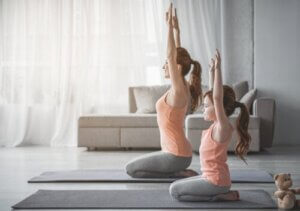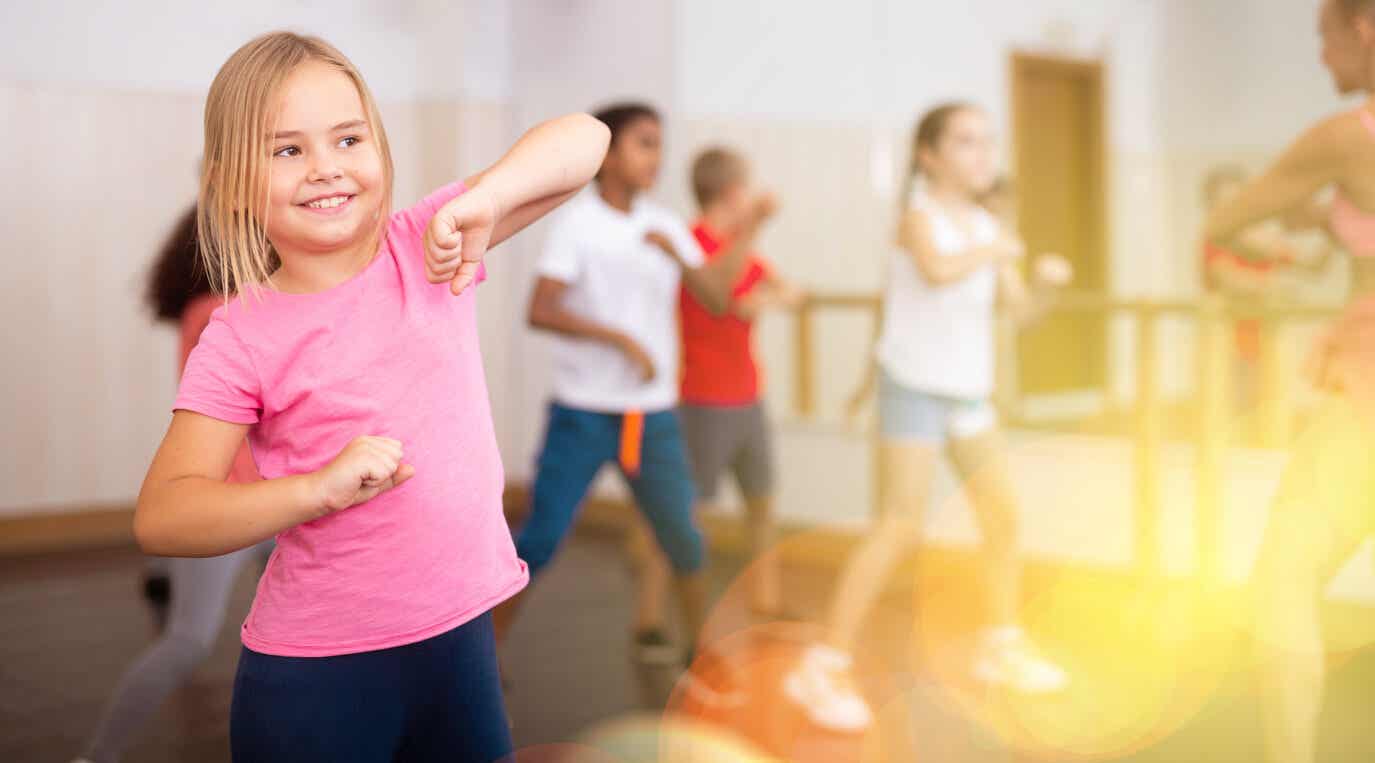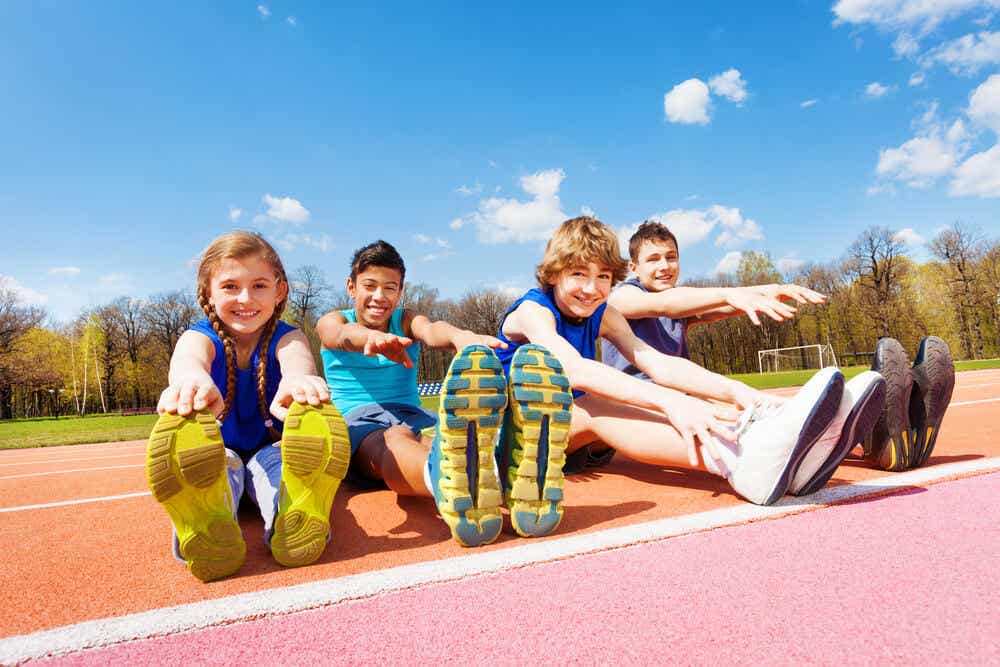5 Activities to Increase Flexibility in Children

Activities to increase flexibility in children contribute to maintaining and enhancing this important human physical capacity.
Flexibility allows us to perform movements of greater amplitude, involving muscles, joints, and other structures of the body. Unfortunately, we lose this ability over time and often abruptly. For this reason, it’s a good idea to work on this skill from an early age.
Flexibility activities for children
The primary objective of these exercises is to ensure the maintenance of this physical capacity over time. But, because we’re talking about children, it’s essential that we capture their attention and motivate them to participate. So, the activities must be attractive and entertaining. Take note of the ones we recommend.
1. Yoga for children
Among the flexibility activities for children, yoga stands out as one of the oldest disciplines in the world.
Yoga for children focuses on working on various body postures, among which static stretching stands out. In addition to working on flexibility in children, this discipline offers a great number of other benefits. For example, relaxation, concentration, and body balance.
This activity is recommended for children between 4 and 12 years of age, however, younger children can participate in less strict approaches to it.
2. Dancing

Although many dances don’t require great dexterity, flexibility is fundamental for joint movement. For this reason, it’s good to practice different genres of dance in order to get the most out of this activity.
In addition to flexibility, other physical abilities such as strength, endurance, and agility are boosted through dance.
3. Group games
The stimulation of flexibility in children occurs in three ways: Static, dynamic, and passive. Through group games, it’s possible to work on this capacity in all its forms.
Passive stretching should be the fundamental axis of group work. The help of another person is recommended, which is why these games should be done in pairs. In the first round, one of the children is in charge of assisting the partner, and in the next round, the roles change.
The teacher, parent, or adult in charge of supervising the activity must make sure that the stretching work is done correctly, in order to prevent injuries from occurring.
4. Swimming
Have you noticed that swimming is beneficial for every aspect of a child’s psychophysical development? Flexibility is certainly no exception.
Children who swim regularly strengthen the four main physical abilities, including flexibility.
Exercise is enhanced in the water, as the resistance offered by the water is greater than that of the air. At the same time, swimming requires the movement of different body segments at the same time, so the physical effort is greater.
Another benefit of this activity is that it allows for both the strengthening and relaxation of muscles at the same time. In addition, it favors the range of motion of the joints.
5. Specific stretching exercises
To increase flexibility in children, they also need to perform specific stretching exercises, that is, those aimed at one or more muscle segments. Some of those recommended for children are those that involve the arms, torso, back, and legs.
Try to warm up briefly before each stretch to activate the muscles and reduce the risk of injury. You should also prevent children from bouncing or sudden movements so that they don’t damage the muscle fibers.

Flexibility depends on the individuality of the children
Although there are multiple alternatives for working on children’s flexibility, you must always keep in mind that each child has a different development process. Age isn’t always a good determinant of the psychophysical level of children, so we need to take into account other individual aspects.
Try to accompany your children to routine medical check-ups and promote a variety of physical activities to improve your children’s physical abilities. Among them, flexibility.
Activities to increase flexibility in children contribute to maintaining and enhancing this important human physical capacity.
Flexibility allows us to perform movements of greater amplitude, involving muscles, joints, and other structures of the body. Unfortunately, we lose this ability over time and often abruptly. For this reason, it’s a good idea to work on this skill from an early age.
Flexibility activities for children
The primary objective of these exercises is to ensure the maintenance of this physical capacity over time. But, because we’re talking about children, it’s essential that we capture their attention and motivate them to participate. So, the activities must be attractive and entertaining. Take note of the ones we recommend.
1. Yoga for children
Among the flexibility activities for children, yoga stands out as one of the oldest disciplines in the world.
Yoga for children focuses on working on various body postures, among which static stretching stands out. In addition to working on flexibility in children, this discipline offers a great number of other benefits. For example, relaxation, concentration, and body balance.
This activity is recommended for children between 4 and 12 years of age, however, younger children can participate in less strict approaches to it.
2. Dancing

Although many dances don’t require great dexterity, flexibility is fundamental for joint movement. For this reason, it’s good to practice different genres of dance in order to get the most out of this activity.
In addition to flexibility, other physical abilities such as strength, endurance, and agility are boosted through dance.
3. Group games
The stimulation of flexibility in children occurs in three ways: Static, dynamic, and passive. Through group games, it’s possible to work on this capacity in all its forms.
Passive stretching should be the fundamental axis of group work. The help of another person is recommended, which is why these games should be done in pairs. In the first round, one of the children is in charge of assisting the partner, and in the next round, the roles change.
The teacher, parent, or adult in charge of supervising the activity must make sure that the stretching work is done correctly, in order to prevent injuries from occurring.
4. Swimming
Have you noticed that swimming is beneficial for every aspect of a child’s psychophysical development? Flexibility is certainly no exception.
Children who swim regularly strengthen the four main physical abilities, including flexibility.
Exercise is enhanced in the water, as the resistance offered by the water is greater than that of the air. At the same time, swimming requires the movement of different body segments at the same time, so the physical effort is greater.
Another benefit of this activity is that it allows for both the strengthening and relaxation of muscles at the same time. In addition, it favors the range of motion of the joints.
5. Specific stretching exercises
To increase flexibility in children, they also need to perform specific stretching exercises, that is, those aimed at one or more muscle segments. Some of those recommended for children are those that involve the arms, torso, back, and legs.
Try to warm up briefly before each stretch to activate the muscles and reduce the risk of injury. You should also prevent children from bouncing or sudden movements so that they don’t damage the muscle fibers.

Flexibility depends on the individuality of the children
Although there are multiple alternatives for working on children’s flexibility, you must always keep in mind that each child has a different development process. Age isn’t always a good determinant of the psychophysical level of children, so we need to take into account other individual aspects.
Try to accompany your children to routine medical check-ups and promote a variety of physical activities to improve your children’s physical abilities. Among them, flexibility.
All cited sources were thoroughly reviewed by our team to ensure their quality, reliability, currency, and validity. The bibliography of this article was considered reliable and of academic or scientific accuracy.
- Conn, A., S. et al. (2017). Un examen de una intervención de yoga con supervivientes de quemaduras pediátricas. J Burn Care Res. 2017 Jan/Feb;38(1):e337-e342. doi: 10.1097/BCR.0000000000000385. PMID: 27380118. Disponible en: https://pubmed.ncbi.nlm.nih.gov/27380118/
- Di Santo, M. (1997). La flexibilidad en las distintas edades de la vida. [Internet] Disponible en: https://g-se.com/la-flexibilidad-en-las-distintas-edades-de-la-vida-37-sa-Y57cfb270e9909
This text is provided for informational purposes only and does not replace consultation with a professional. If in doubt, consult your specialist.








